Finance Report: International Finance and Operating Exposure in UAE
VerifiedAdded on 2020/05/11
|6
|1435
|72
Report
AI Summary
This finance report provides an analysis of Foreign Direct Investment (FDI) in the United Arab Emirates (UAE), focusing on the strategies and risks associated with international business expansion. The report uses Boeing and Microsoft as case studies to illustrate successful approaches to navigating financial and operational challenges in the UAE market. It explores the risks related to foreign exchange, political instability, and cross-cultural factors. The report examines the companies' strategies for managing investment in infrastructure, complying with FDI norms, and forming alliances with the government. The report also addresses operating exposure, analyzing the impact of exchange rate fluctuations on company revenues and costs. It provides an overview of financial hedging techniques to mitigate risks, including operational and financial strategies. The methodology includes case studies, primary analysis, surveys, and sensitivity analysis, using data from company annual reports and other public sources. The findings highlight the importance of aligning business operations with FDI regulations and building strong government partnerships. The report concludes that effective risk management and strategic planning are key to success in the international market.
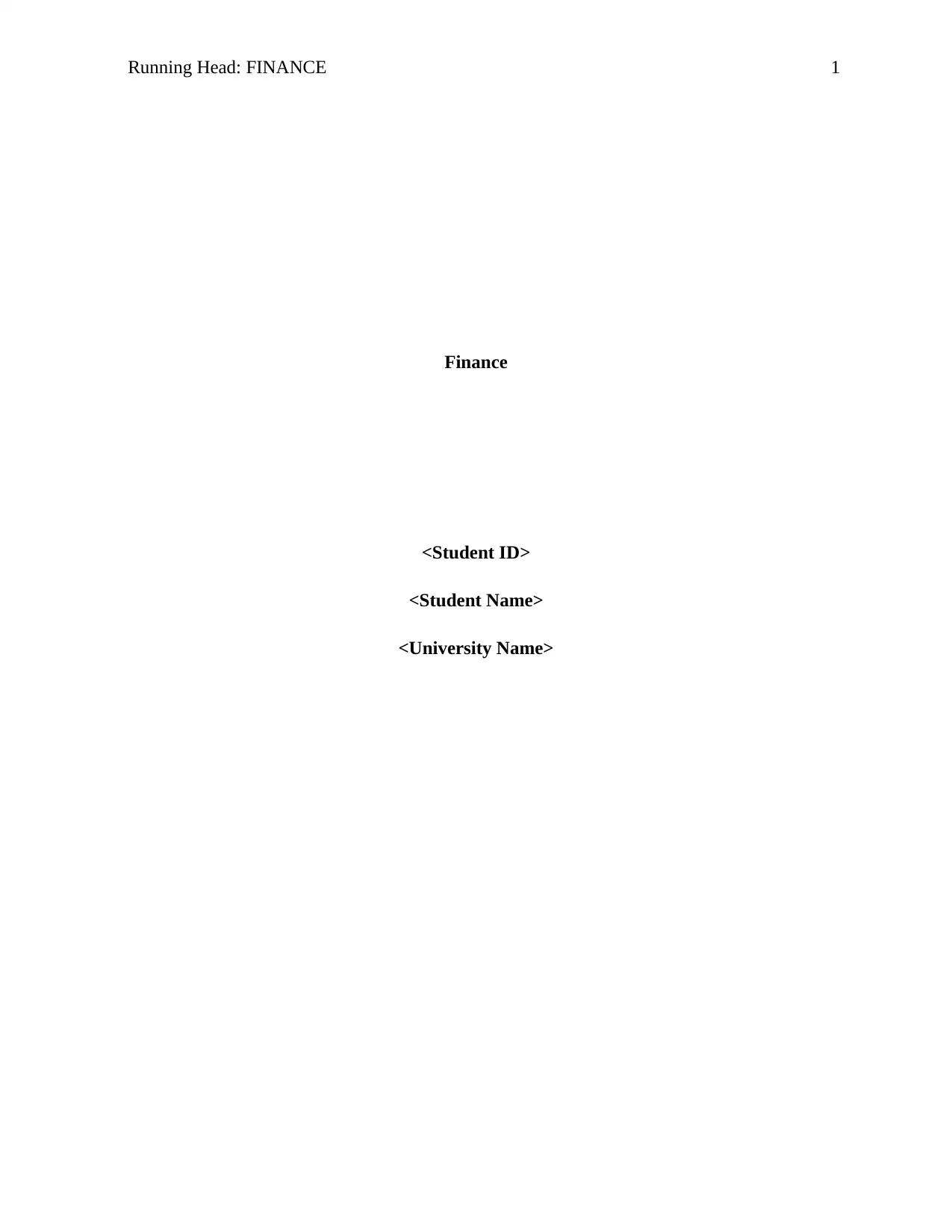
Running Head: FINANCE 1
Finance
<Student ID>
<Student Name>
<University Name>
Finance
<Student ID>
<Student Name>
<University Name>
Paraphrase This Document
Need a fresh take? Get an instant paraphrase of this document with our AI Paraphraser
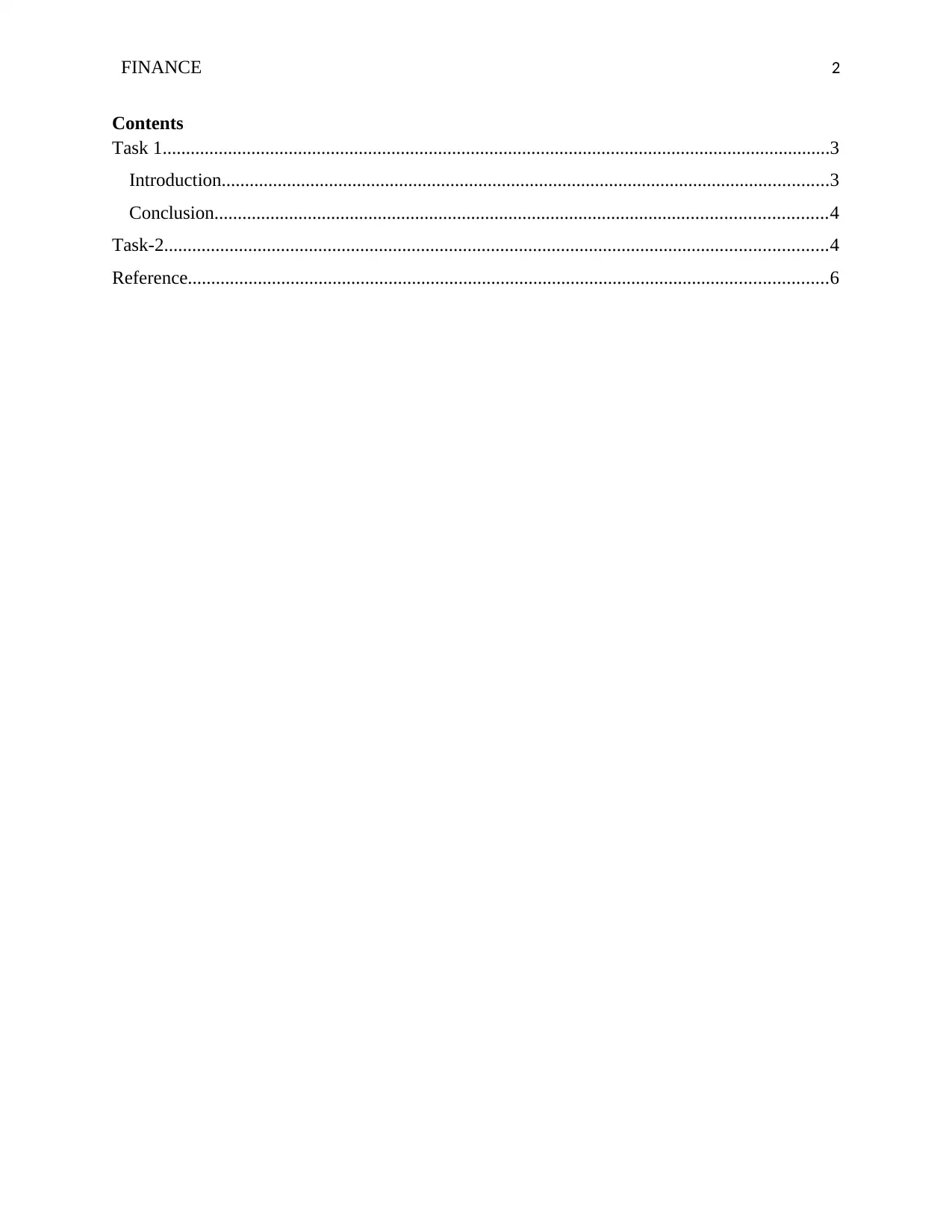
FINANCE 2
Contents
Task 1...............................................................................................................................................3
Introduction..................................................................................................................................3
Conclusion...................................................................................................................................4
Task-2..............................................................................................................................................4
Reference.........................................................................................................................................6
Contents
Task 1...............................................................................................................................................3
Introduction..................................................................................................................................3
Conclusion...................................................................................................................................4
Task-2..............................................................................................................................................4
Reference.........................................................................................................................................6
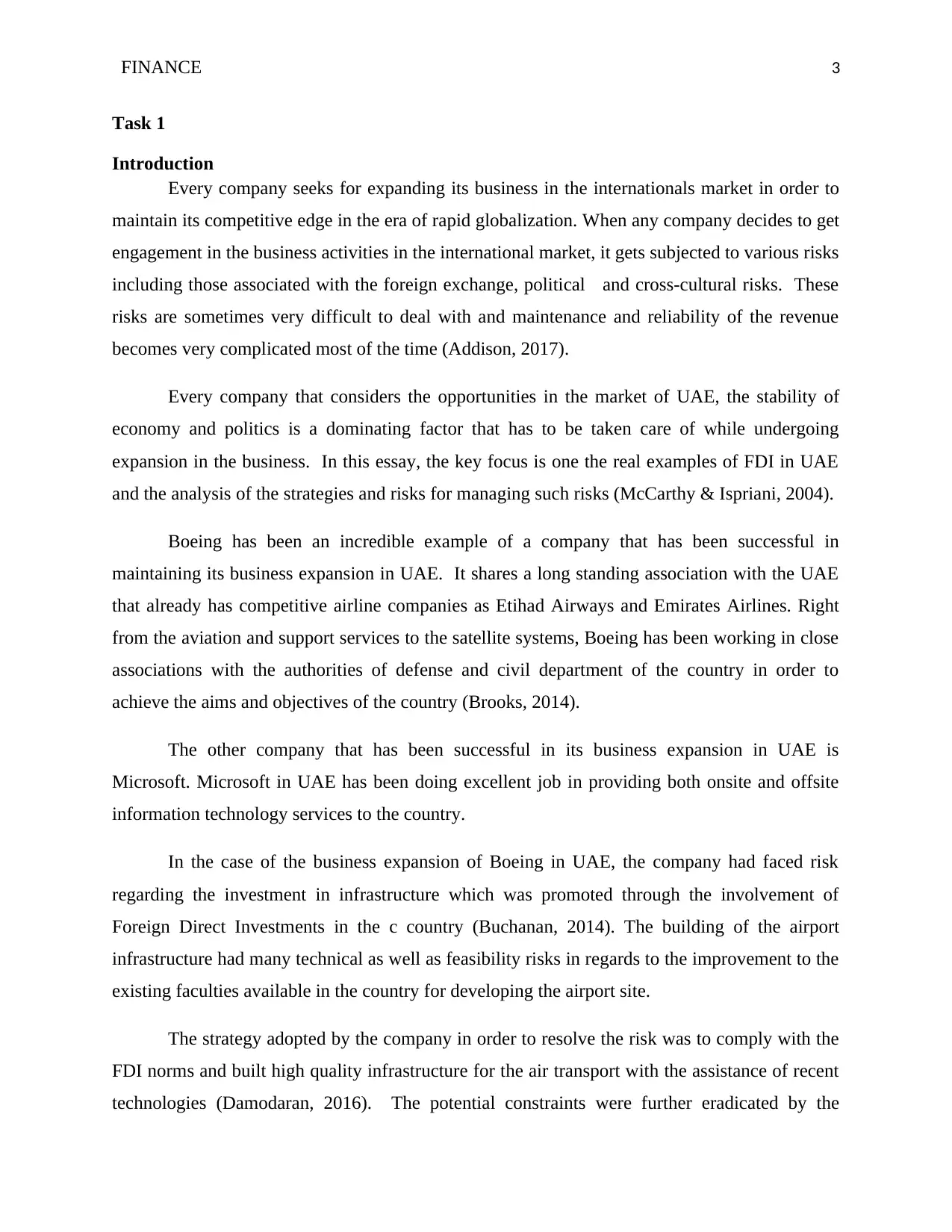
FINANCE 3
Task 1
Introduction
Every company seeks for expanding its business in the internationals market in order to
maintain its competitive edge in the era of rapid globalization. When any company decides to get
engagement in the business activities in the international market, it gets subjected to various risks
including those associated with the foreign exchange, political and cross-cultural risks. These
risks are sometimes very difficult to deal with and maintenance and reliability of the revenue
becomes very complicated most of the time (Addison, 2017).
Every company that considers the opportunities in the market of UAE, the stability of
economy and politics is a dominating factor that has to be taken care of while undergoing
expansion in the business. In this essay, the key focus is one the real examples of FDI in UAE
and the analysis of the strategies and risks for managing such risks (McCarthy & Ispriani, 2004).
Boeing has been an incredible example of a company that has been successful in
maintaining its business expansion in UAE. It shares a long standing association with the UAE
that already has competitive airline companies as Etihad Airways and Emirates Airlines. Right
from the aviation and support services to the satellite systems, Boeing has been working in close
associations with the authorities of defense and civil department of the country in order to
achieve the aims and objectives of the country (Brooks, 2014).
The other company that has been successful in its business expansion in UAE is
Microsoft. Microsoft in UAE has been doing excellent job in providing both onsite and offsite
information technology services to the country.
In the case of the business expansion of Boeing in UAE, the company had faced risk
regarding the investment in infrastructure which was promoted through the involvement of
Foreign Direct Investments in the c country (Buchanan, 2014). The building of the airport
infrastructure had many technical as well as feasibility risks in regards to the improvement to the
existing faculties available in the country for developing the airport site.
The strategy adopted by the company in order to resolve the risk was to comply with the
FDI norms and built high quality infrastructure for the air transport with the assistance of recent
technologies (Damodaran, 2016). The potential constraints were further eradicated by the
Task 1
Introduction
Every company seeks for expanding its business in the internationals market in order to
maintain its competitive edge in the era of rapid globalization. When any company decides to get
engagement in the business activities in the international market, it gets subjected to various risks
including those associated with the foreign exchange, political and cross-cultural risks. These
risks are sometimes very difficult to deal with and maintenance and reliability of the revenue
becomes very complicated most of the time (Addison, 2017).
Every company that considers the opportunities in the market of UAE, the stability of
economy and politics is a dominating factor that has to be taken care of while undergoing
expansion in the business. In this essay, the key focus is one the real examples of FDI in UAE
and the analysis of the strategies and risks for managing such risks (McCarthy & Ispriani, 2004).
Boeing has been an incredible example of a company that has been successful in
maintaining its business expansion in UAE. It shares a long standing association with the UAE
that already has competitive airline companies as Etihad Airways and Emirates Airlines. Right
from the aviation and support services to the satellite systems, Boeing has been working in close
associations with the authorities of defense and civil department of the country in order to
achieve the aims and objectives of the country (Brooks, 2014).
The other company that has been successful in its business expansion in UAE is
Microsoft. Microsoft in UAE has been doing excellent job in providing both onsite and offsite
information technology services to the country.
In the case of the business expansion of Boeing in UAE, the company had faced risk
regarding the investment in infrastructure which was promoted through the involvement of
Foreign Direct Investments in the c country (Buchanan, 2014). The building of the airport
infrastructure had many technical as well as feasibility risks in regards to the improvement to the
existing faculties available in the country for developing the airport site.
The strategy adopted by the company in order to resolve the risk was to comply with the
FDI norms and built high quality infrastructure for the air transport with the assistance of recent
technologies (Damodaran, 2016). The potential constraints were further eradicated by the
⊘ This is a preview!⊘
Do you want full access?
Subscribe today to unlock all pages.

Trusted by 1+ million students worldwide
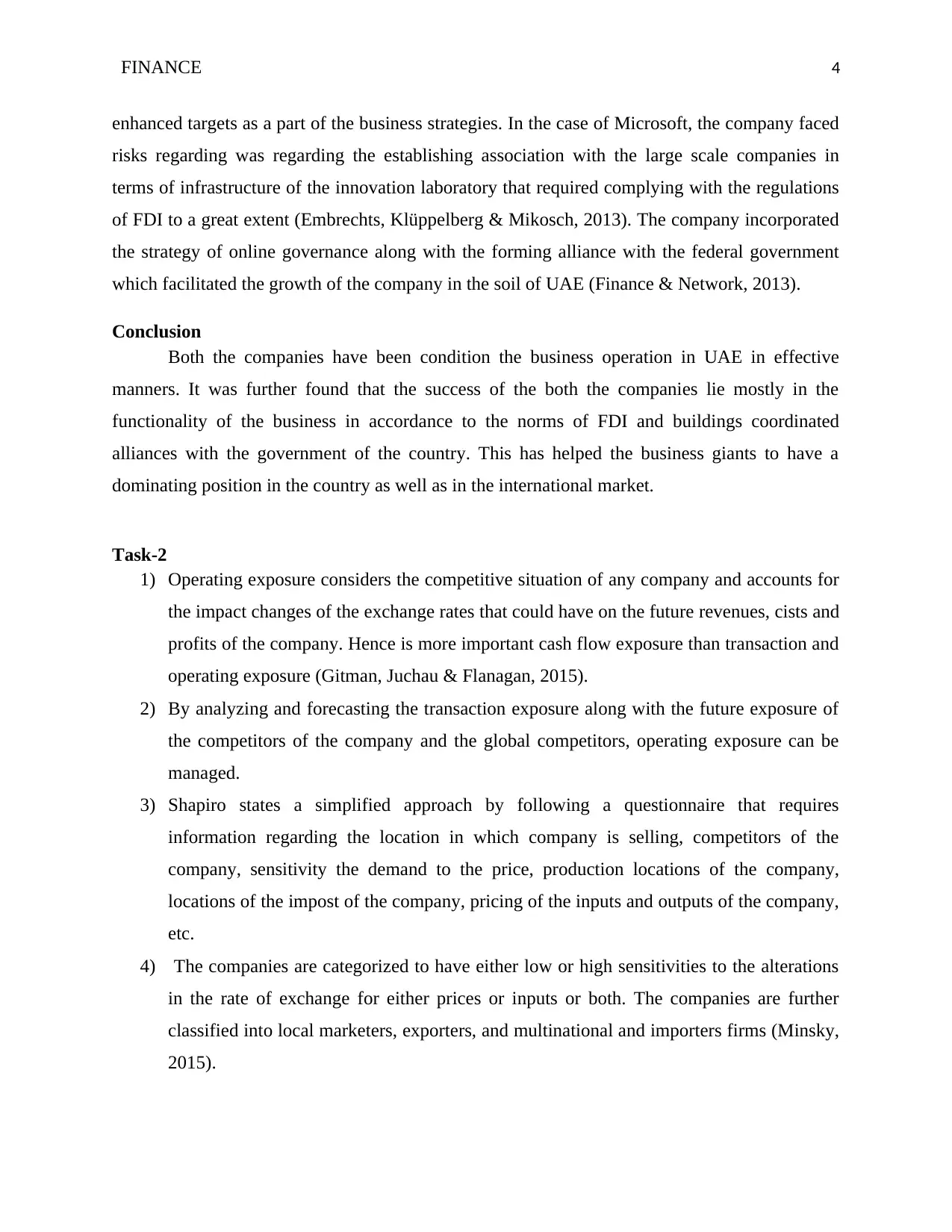
FINANCE 4
enhanced targets as a part of the business strategies. In the case of Microsoft, the company faced
risks regarding was regarding the establishing association with the large scale companies in
terms of infrastructure of the innovation laboratory that required complying with the regulations
of FDI to a great extent (Embrechts, Klüppelberg & Mikosch, 2013). The company incorporated
the strategy of online governance along with the forming alliance with the federal government
which facilitated the growth of the company in the soil of UAE (Finance & Network, 2013).
Conclusion
Both the companies have been condition the business operation in UAE in effective
manners. It was further found that the success of the both the companies lie mostly in the
functionality of the business in accordance to the norms of FDI and buildings coordinated
alliances with the government of the country. This has helped the business giants to have a
dominating position in the country as well as in the international market.
Task-2
1) Operating exposure considers the competitive situation of any company and accounts for
the impact changes of the exchange rates that could have on the future revenues, cists and
profits of the company. Hence is more important cash flow exposure than transaction and
operating exposure (Gitman, Juchau & Flanagan, 2015).
2) By analyzing and forecasting the transaction exposure along with the future exposure of
the competitors of the company and the global competitors, operating exposure can be
managed.
3) Shapiro states a simplified approach by following a questionnaire that requires
information regarding the location in which company is selling, competitors of the
company, sensitivity the demand to the price, production locations of the company,
locations of the impost of the company, pricing of the inputs and outputs of the company,
etc.
4) The companies are categorized to have either low or high sensitivities to the alterations
in the rate of exchange for either prices or inputs or both. The companies are further
classified into local marketers, exporters, and multinational and importers firms (Minsky,
2015).
enhanced targets as a part of the business strategies. In the case of Microsoft, the company faced
risks regarding was regarding the establishing association with the large scale companies in
terms of infrastructure of the innovation laboratory that required complying with the regulations
of FDI to a great extent (Embrechts, Klüppelberg & Mikosch, 2013). The company incorporated
the strategy of online governance along with the forming alliance with the federal government
which facilitated the growth of the company in the soil of UAE (Finance & Network, 2013).
Conclusion
Both the companies have been condition the business operation in UAE in effective
manners. It was further found that the success of the both the companies lie mostly in the
functionality of the business in accordance to the norms of FDI and buildings coordinated
alliances with the government of the country. This has helped the business giants to have a
dominating position in the country as well as in the international market.
Task-2
1) Operating exposure considers the competitive situation of any company and accounts for
the impact changes of the exchange rates that could have on the future revenues, cists and
profits of the company. Hence is more important cash flow exposure than transaction and
operating exposure (Gitman, Juchau & Flanagan, 2015).
2) By analyzing and forecasting the transaction exposure along with the future exposure of
the competitors of the company and the global competitors, operating exposure can be
managed.
3) Shapiro states a simplified approach by following a questionnaire that requires
information regarding the location in which company is selling, competitors of the
company, sensitivity the demand to the price, production locations of the company,
locations of the impost of the company, pricing of the inputs and outputs of the company,
etc.
4) The companies are categorized to have either low or high sensitivities to the alterations
in the rate of exchange for either prices or inputs or both. The companies are further
classified into local marketers, exporters, and multinational and importers firms (Minsky,
2015).
Paraphrase This Document
Need a fresh take? Get an instant paraphrase of this document with our AI Paraphraser
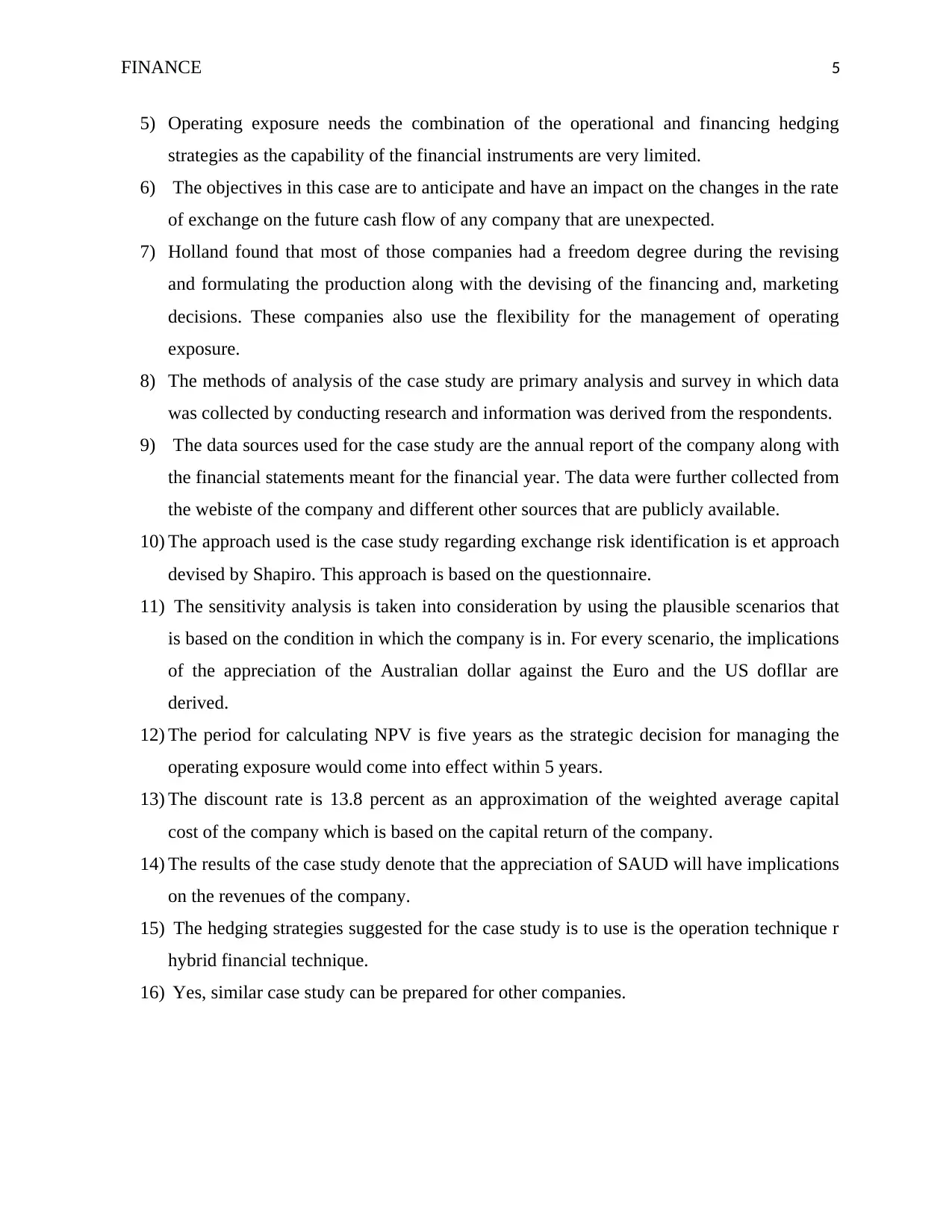
FINANCE 5
5) Operating exposure needs the combination of the operational and financing hedging
strategies as the capability of the financial instruments are very limited.
6) The objectives in this case are to anticipate and have an impact on the changes in the rate
of exchange on the future cash flow of any company that are unexpected.
7) Holland found that most of those companies had a freedom degree during the revising
and formulating the production along with the devising of the financing and, marketing
decisions. These companies also use the flexibility for the management of operating
exposure.
8) The methods of analysis of the case study are primary analysis and survey in which data
was collected by conducting research and information was derived from the respondents.
9) The data sources used for the case study are the annual report of the company along with
the financial statements meant for the financial year. The data were further collected from
the webiste of the company and different other sources that are publicly available.
10) The approach used is the case study regarding exchange risk identification is et approach
devised by Shapiro. This approach is based on the questionnaire.
11) The sensitivity analysis is taken into consideration by using the plausible scenarios that
is based on the condition in which the company is in. For every scenario, the implications
of the appreciation of the Australian dollar against the Euro and the US dofllar are
derived.
12) The period for calculating NPV is five years as the strategic decision for managing the
operating exposure would come into effect within 5 years.
13) The discount rate is 13.8 percent as an approximation of the weighted average capital
cost of the company which is based on the capital return of the company.
14) The results of the case study denote that the appreciation of SAUD will have implications
on the revenues of the company.
15) The hedging strategies suggested for the case study is to use is the operation technique r
hybrid financial technique.
16) Yes, similar case study can be prepared for other companies.
5) Operating exposure needs the combination of the operational and financing hedging
strategies as the capability of the financial instruments are very limited.
6) The objectives in this case are to anticipate and have an impact on the changes in the rate
of exchange on the future cash flow of any company that are unexpected.
7) Holland found that most of those companies had a freedom degree during the revising
and formulating the production along with the devising of the financing and, marketing
decisions. These companies also use the flexibility for the management of operating
exposure.
8) The methods of analysis of the case study are primary analysis and survey in which data
was collected by conducting research and information was derived from the respondents.
9) The data sources used for the case study are the annual report of the company along with
the financial statements meant for the financial year. The data were further collected from
the webiste of the company and different other sources that are publicly available.
10) The approach used is the case study regarding exchange risk identification is et approach
devised by Shapiro. This approach is based on the questionnaire.
11) The sensitivity analysis is taken into consideration by using the plausible scenarios that
is based on the condition in which the company is in. For every scenario, the implications
of the appreciation of the Australian dollar against the Euro and the US dofllar are
derived.
12) The period for calculating NPV is five years as the strategic decision for managing the
operating exposure would come into effect within 5 years.
13) The discount rate is 13.8 percent as an approximation of the weighted average capital
cost of the company which is based on the capital return of the company.
14) The results of the case study denote that the appreciation of SAUD will have implications
on the revenues of the company.
15) The hedging strategies suggested for the case study is to use is the operation technique r
hybrid financial technique.
16) Yes, similar case study can be prepared for other companies.
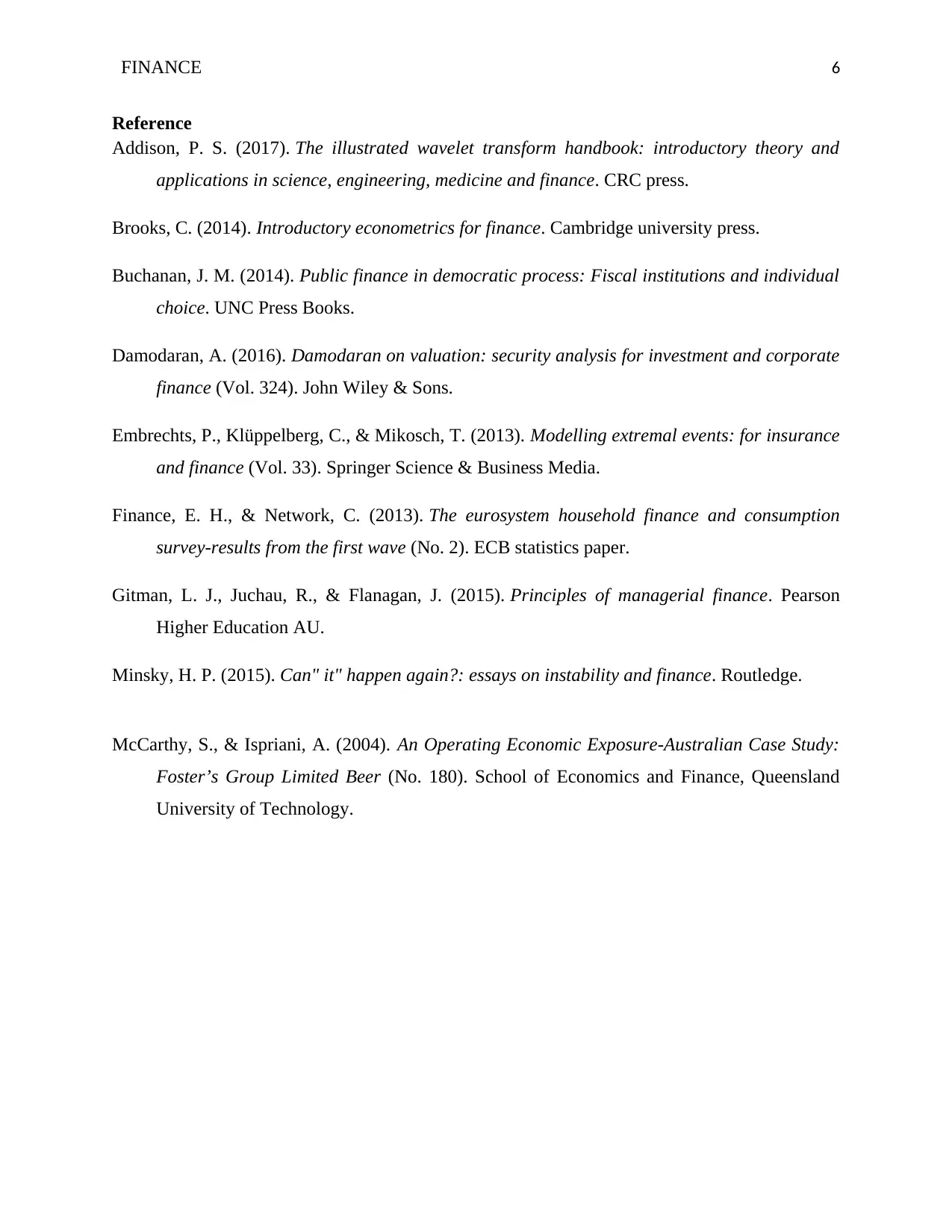
FINANCE 6
Reference
Addison, P. S. (2017). The illustrated wavelet transform handbook: introductory theory and
applications in science, engineering, medicine and finance. CRC press.
Brooks, C. (2014). Introductory econometrics for finance. Cambridge university press.
Buchanan, J. M. (2014). Public finance in democratic process: Fiscal institutions and individual
choice. UNC Press Books.
Damodaran, A. (2016). Damodaran on valuation: security analysis for investment and corporate
finance (Vol. 324). John Wiley & Sons.
Embrechts, P., Klüppelberg, C., & Mikosch, T. (2013). Modelling extremal events: for insurance
and finance (Vol. 33). Springer Science & Business Media.
Finance, E. H., & Network, C. (2013). The eurosystem household finance and consumption
survey-results from the first wave (No. 2). ECB statistics paper.
Gitman, L. J., Juchau, R., & Flanagan, J. (2015). Principles of managerial finance. Pearson
Higher Education AU.
Minsky, H. P. (2015). Can" it" happen again?: essays on instability and finance. Routledge.
McCarthy, S., & Ispriani, A. (2004). An Operating Economic Exposure-Australian Case Study:
Foster’s Group Limited Beer (No. 180). School of Economics and Finance, Queensland
University of Technology.
Reference
Addison, P. S. (2017). The illustrated wavelet transform handbook: introductory theory and
applications in science, engineering, medicine and finance. CRC press.
Brooks, C. (2014). Introductory econometrics for finance. Cambridge university press.
Buchanan, J. M. (2014). Public finance in democratic process: Fiscal institutions and individual
choice. UNC Press Books.
Damodaran, A. (2016). Damodaran on valuation: security analysis for investment and corporate
finance (Vol. 324). John Wiley & Sons.
Embrechts, P., Klüppelberg, C., & Mikosch, T. (2013). Modelling extremal events: for insurance
and finance (Vol. 33). Springer Science & Business Media.
Finance, E. H., & Network, C. (2013). The eurosystem household finance and consumption
survey-results from the first wave (No. 2). ECB statistics paper.
Gitman, L. J., Juchau, R., & Flanagan, J. (2015). Principles of managerial finance. Pearson
Higher Education AU.
Minsky, H. P. (2015). Can" it" happen again?: essays on instability and finance. Routledge.
McCarthy, S., & Ispriani, A. (2004). An Operating Economic Exposure-Australian Case Study:
Foster’s Group Limited Beer (No. 180). School of Economics and Finance, Queensland
University of Technology.
⊘ This is a preview!⊘
Do you want full access?
Subscribe today to unlock all pages.

Trusted by 1+ million students worldwide
1 out of 6
Related Documents
Your All-in-One AI-Powered Toolkit for Academic Success.
+13062052269
info@desklib.com
Available 24*7 on WhatsApp / Email
![[object Object]](/_next/static/media/star-bottom.7253800d.svg)
Unlock your academic potential
Copyright © 2020–2025 A2Z Services. All Rights Reserved. Developed and managed by ZUCOL.





